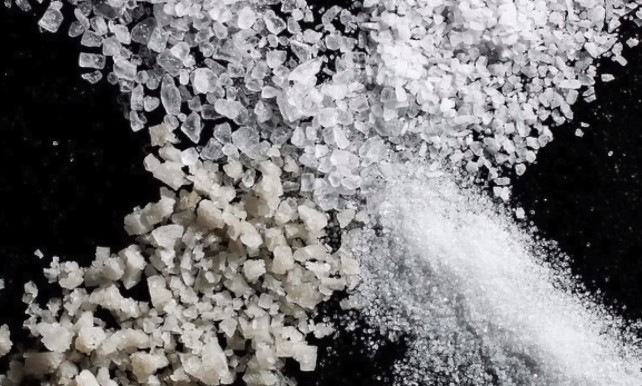Sea Salt Nutrition Facts
Sea Salt nutrition facts may not be something you've considered before, but understanding the surprising intricacies behind this ordinary kitchen ingredient can be quite enlightening. Our deep dive into this familiar mineral will challenge you to rethink its role in your diet, promising revelations you won't want to miss.
Celtic sea salt nutrition facts are key to understanding why this humble condiment has been revered since ancient times. Beyond the exciting zest it brings to our meals, sea salt is loaded with vital minerals and nutrients that contribute to overall health. Buckle up as we embark on a salty journey to unlock the secrets of sea salt, its nutritional content, and its potential benefits.
Understanding Different Types of Salt
When discussing types of salt, it’s important to know that all salts, whether sea, table, or Himalayan, share the common element sodium chloride. However, what differentiates them are the trace minerals and impurities they contain. Let’s delve into two popular types: sea salt and Himalayan salt.
Due to its trace mineral content, the nutritional facts of Himalayan sea salt are compelling. This pink-hued salt is mined from the Khewra Salt Mine in Pakistan, and it’s touted for having up to 84 trace minerals. Nevertheless, these minerals are present in such minute quantities that they are unlikely to bring significant dietary benefits.
On the other hand, Celtic sea salt nutrition facts tell a similar tale. Harvested from tidal ponds off the coast of France, Celtic sea salt boasts grayish crystals packed with moisture. While it also contains trace minerals, like magnesium and iron, the quantities are insufficient to supplement a regular diet.

Sea Salt vs. Table Salt Nutrition Facts
Sea salt vs. table salt Nutrition Facts is a riveting discussion that often pops up among health enthusiasts. While sea salt is derived directly from the evaporation of seawater, table salt is mined from underground salt deposits. Moreover, table salt usually undergoes a refining process that strips it of any trace minerals, thus leaving it primarily with sodium chloride. However, sea salt and table salt contain nearly equal amounts of sodium by weight.
Many believe that sea salt is healthier than table salt, but the truth is a little more complex. While it’s true that sea salt may contain trace minerals that table salt lacks, the quantities of these minerals are too small to make a substantial difference in your diet. Sea Salt calories are identical to table salt; both are virtually calorie-free.

Unveiling Specific Sea Salt Nutrition Facts
Sea salt nutrition facts 100g reveal that sea salt primarily consists of sodium chloride. It contains around 38,000 to 39,000 mg of sodium per 100g. This equates to approximately 1600mg of sodium per 1 teaspoon, about two-thirds of the recommended daily allowance of sodium for adults.
Furthermore, a glance at the keto sea salt caramel ice cream bars’ nutrition facts and 85 degrees sea salt coffee’s nutrition facts will show how sea salt heightens flavor in these products. Despite being used in sweet treats, adding sea salt does not contribute any significant calories.
Comprehensive Nutrition Table
| Nutrient | Quantity (Per 100g of Sea Salt) |
|---|---|
| Calcium | 0.04% of Daily Value (DV) |
| Magnesium | 0.3% of DV |
| Potassium | 0.1% of DV |
| Iron | 0.2% of DV |
| Sodium | 38,000-39,000mg |
F.A.Q.’s
What is the nutritional value of 1 teaspoon of sea salt?
A teaspoon of sea salt contains around 2000 milligrams of sodium. However, the exact amount can vary depending on the size of the salt crystals. It's important to note that the American Heart Association recommends limiting sodium intake to 1500 milligrams a day to maintain heart health.
What are the benefits of sea salt?
While sea salt shares many similarities with table salt, it does hold a couple of extra perks. First, because sea salt undergoes less processing, it retains trace minerals that table salt does not. Additionally, sea salt's unique flavors and textures can enhance the culinary experience, adding a new depth to your dishes.
Is sea salt a healthy salt?
It's important to remember that the primary nutrient in both sea salt and table salt is sodium. Excessive sodium intake can lead to high blood pressure and heart disease, regardless of the source. Thus, while sea salt may have a slight edge in terms of mineral content, it is not inherently healthier than table salt. Moderation is key when consuming any type of salt.
What are the nutrients in sea salt?
Sea salt does offer Sea salt mineral content, including calcium, potassium, magnesium, and trace amounts of other elements. However, these are present in minute quantities. Most sea salt minerals are sodium, accounting for about 98% of the total content. So, while sea salt contains more nutrients than table salt, its dietary contributions are relatively minimal.
Conclusion
From the above exploration of boom chicka pop nutrition facts sea salt, Celtic sea salt nutrition facts, and Sea salt nutrition facts 100g, it’s clear that sea salt is a flavorful addition to our meals. It can enhance the taste of various dishes, from sweets like keto sea salt caramel ice cream bars to savory snacks and beverages like 85 degrees sea salt coffee. However, regarding nutritional content, the differences between sea salt and table salt are minor and unlikely to impact your overall diet significantly.
Remember, the key to a healthy diet isn’t just about choosing sea salt over table salt or vice versa. It’s about mindful eating and maintaining a balanced intake of nutrients. So the next time you reach for the salt, remember that whether it’s sea salt or table salt, it’s the quantity that truly matters.
Read also:





